By sailing south, leaving the coast of Chile on our left, we reached Chiloe (pronounced ‘CHILL-O-WAY’) Island around 7.30 a.m.in the morning. Having reached a suitable anchorage just off the small port of Achao, the ship dropped anchor whilst the guests enjoyed breakfast. Achao is located on a smaller island called Isla Quinchao which lies to the east of the much larger island Chiloe.
Chile takes the protection of the land, forests and animals from the accidental introduction of foreign species or disease very seriously. The Agricultural and Livestock Service examines any baggage landed from ships or aircraft. At Niebla the previous day, Chilean officials had come aboard to examine passenger’s rucksacks before we left the ship but at Achao the Agricultural and Livestock Service had set up a tent on the jetty so the Zodiacs were able to start ferrying passengers ashore for the ‘Chiloe Highlights Tour’.
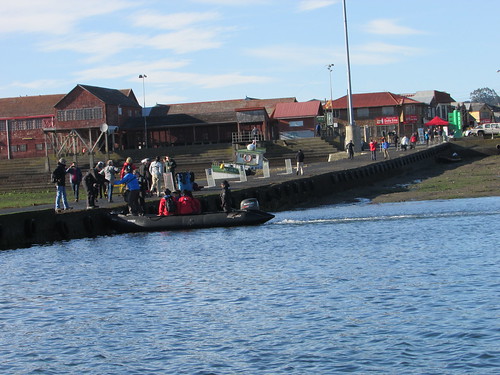
Passengers from 'Silver Explorer' landing by 'Zodiac' at Achao.
At Achao (population around 2,500), the simple jetty inclined down from the road across the beach and into the sea supports a total of nine ferry services which use small passenger ferries to link the town to outlying islands. According to the importance of the destination, the service frequency varies from daily to four days in a week. As I disembarked from the Zodiac, a motor launch on one of the ferry routes arrived at the jetty and disembarked around 16 local passengers.
The Silversea guests were met by a local guide with excellent English who suggested walking a few hundred yards through the town to Achao Church. Built in 1730, this is the oldest surviving wooden building in Chile and a World Heritage Site. Local boat builders adapted their construction techniques to produce a durable church completely out of wood for the Jesuit missionaries. Local houses were built using similar methods and were clad in wooden shingles where each family developed its own distinctive shape for the shingle.
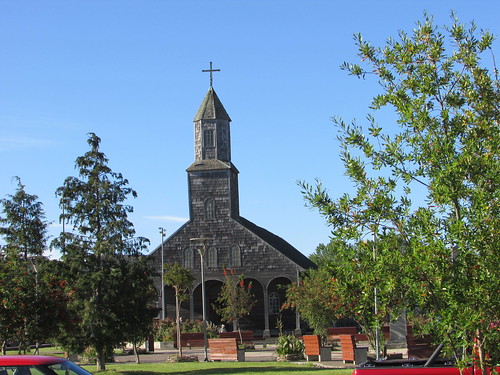
Achao: Wooden church.
There is a second wooden church in the town which we were unable to visit as it was temporarily closed for termite eradication.
We then boarded one of three tour buses to see more of the island. We drove north west through a relatively-prosperous landscape which offered tantalising views of the sea and, again, was reminiscent of Cornwall. Eventually we descended a steep hill and came to an abrupt stop with the channel dividing us from Chiloe Island in front of us. A car ferry which crosses the channel was loading but there was insufficient space for us. Within a few minutes, another ferry arrived but this one was smaller and provided with a loading ramp at one end only. The smaller ferry unloaded and refilled with waiting cars and pick-up trucks which all had to reverse up the ramp onto the ferry.
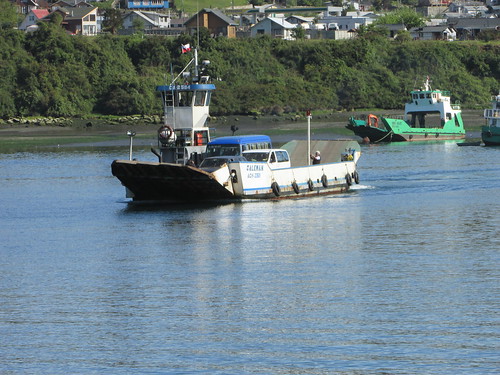
Dalcahue, Chile: One of the vehicle ferries connecting Chiloe and Isla Quinchao.
After another short wait, a larger ferry with two loading ramps appeared allowing our coach (with all passengers remaining on board) to drive forward onto the ferry and, after a crossing of about ten minutes, to continue forward, leaving by the second ramp. We were immediately in the small town of Dalcahue on Chiloe. Our tour bus dropped us at a large market building crammed with locally-made craft products.
Dalcahue also has a wooden church which is a World Heritage Site but this building had required some restoration recently. The nave had a simple barrel-vault ceiling supported by a series of wooden posts which had been clad and painted to represent the arcading and marble columns of a stone building.
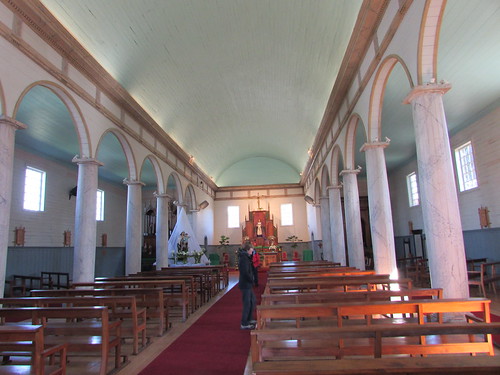
Dalcahue, Chile: Wooden church.
Our bus then drove us to the main city of Castro, using Route 5 which forms part of the Pan-American Highway. Arriving in Castro, our coach paused at a viewpoint overlooking the series of 'stilt houses' built out over the water on tall posts called the Palafitos of Gamboa.

Castro, Chile: The Palafitos of Gamboa.
After a short drive, we left the coach and walked to a local restaurant also built on posts over the water (although the state of the tide meant that there was no water during our visit). Here we enjoyed “a snack and typical local music”. Outside, considerable interest was created by Ray, the “Ship’s Videographer” who was using his radio-controlled drone to collect aerial pictures.
In the shallows, a number of locals were collecting seaweed – the ‘green’ variety is used as a fertiliser and the ‘white’ is used as a source for Agar Jelly, widely used for culture-growing in laboratories.
During the morning, we’d travelled many miles by coach from Achao to Castro. Rather than requiring us to drive back to Achao to re-join the ship, in an innovation carried out for the first time on our trip the ship had sailed from Achao to Castro and, as we watched the seaweed collectors, ‘Silver Explorer’ appeared round the headland and slowly moved to an anchorage only a few hundred yards from Castro’s jetty. The ship lowered a number of Zodiacs into the water in order to collect the guests from the shore.
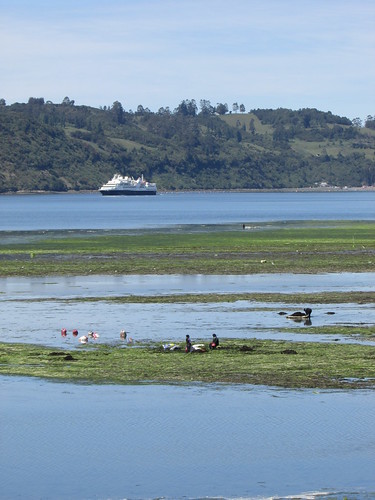
Castro, Chile: Workers collecting seaweed as 'Silver Explorer' arrives to pick up passengers from the ‘Chiloe Highlights Tour’.
Tour buses were on hand to take guests from the local restaurant to the jetty, with the option of instead walking to the jetty. Since the sun was shining brightly and the distance was only a few hundred yards, I and a number of the guests decided to walk. After passing a row of houses, we came to a large covered dry goods market incorporating a fresh fish market. Having spent a few minutes touring the market, I examined three incomplete ‘portable engines’ on display outside in an incomplete state.
A portable engine is similar to a traction engine except that it is not self-propelled. It has to be towed into position, when its steam engine can be connected by belt drive to a piece of unpowered machinery like a threshing machine or a sawbench. Two of the portable engines were made by Ransomes in England but the manufacturer of the third was unclear.
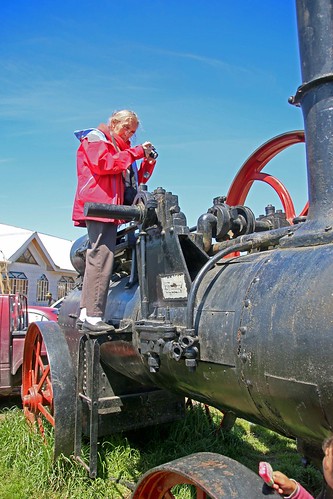
Castro, Chile: Jan examining a Portable Engine (Photo: Peter Fraenkel).
A further short walk took me to the small Castro Terminal Building. Once through the building, I was on the jetty, with a few other guests from the ship. We took the last Zodiac back to the ship and were back on board a few minutes after one o’clock.
I found I was ready for lunch in the restaurant after the exertions of the morning. There were two lectures during the afternoon but I worked on the computer instead. Just after four o’clock, I took afternoon tea in the Panorama Lounge with two new friends from Australia before continuing on the computer until the Expedition Team Recap and Briefing, which reviewed the day’s outing and outlined the plans for the following day. Then it was time for a leisurely dinner with another new friend before retiring.
Related Posts
Next post describing this trip: Puerto Chacabuco.
All posts describing this trip: Chilean Fjords.
My pictures
Where necessary, clicking on an image above will display an 'uncropped' view or, alternately, my pictures from this (and earlier) trips may be selected, viewed or downloaded, in various sizes, from the albums listed:-
Pictures of Achao and Castro are here.
Pictures aboard 'Silver Explorer' are here.
All my pictures of Chile can be found in the collection Chile.
[Pictures added 11-Jan-2017]
